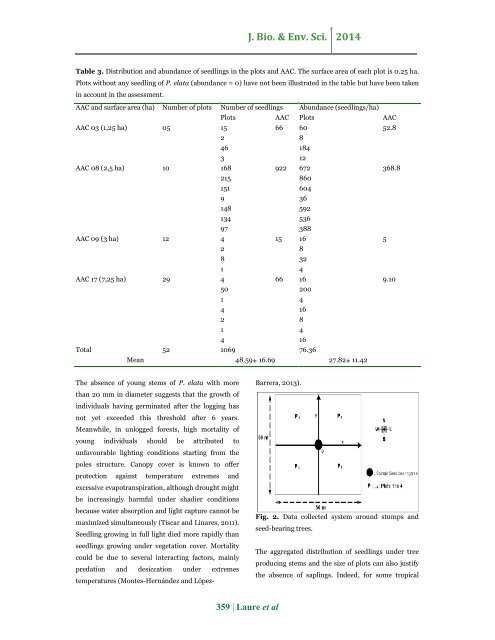Early growth stages structure and distribution of Pericopsis elata (Harms) van Meeuven in a logging concession of South – East Cameroon
Abstract Pericopsis elata (Harms) van Meeuwen is a tropical Africa's timber of high economic value. In many countries its low natural regeneration rate does not favor the replacement of harvested populations, thus CITES and IUCN recommended a total protection of the species. This survey aimed to characterize the early growth stages and natural regeneration of P. elata through the determination of seedlings distribution and structure. Squared plots of 2500 m² were installed around stumps and seed-bearing trees respectively in the logged and unlogged forest concessions at Ouesso, near Yokadouma, South-East Cameroon. Stumps, seed-bearing trees and seedlings were counted and their structural parameters (diameter and height) were recorded. A total of 56 plots corresponding to 14 ha were surveyed and 1069 seedlings were recorded. The rate of regeneration was 56% around stumps and 24.13% around seed-bearing trees. The spatial distribution of seedlings appears to be aggregated. Germination and seedling growth have shown that early growth stages of Pericopsis elata are not representing a relevant limiting factor for the evolution of population. However, the limited number of saplings and the lack of poles suggest that light could play and important role in the evolution of the early stages.
Abstract
Pericopsis elata (Harms) van Meeuwen is a tropical Africa's timber of high economic value. In many countries its low natural regeneration rate does not favor the replacement of harvested populations, thus CITES and IUCN recommended a total protection of the species. This survey aimed to characterize the early growth stages and natural regeneration of P. elata through the determination of seedlings distribution and structure. Squared plots
of 2500 m² were installed around stumps and seed-bearing trees respectively in the logged and unlogged forest concessions at Ouesso, near Yokadouma, South-East Cameroon. Stumps, seed-bearing trees and seedlings were counted and their structural parameters (diameter and height) were recorded. A total of 56 plots corresponding to 14 ha were surveyed and 1069 seedlings were recorded. The rate of regeneration was 56% around stumps and 24.13% around seed-bearing trees. The spatial distribution of seedlings appears to be aggregated. Germination and seedling growth have shown that early growth stages of Pericopsis elata are not representing a relevant limiting factor for the evolution of population. However, the limited number of saplings and the lack of poles
suggest that light could play and important role in the evolution of the early stages.
You also want an ePaper? Increase the reach of your titles
YUMPU automatically turns print PDFs into web optimized ePapers that Google loves.
J. Bio. & Env. Sci. 2014<br />
Table 3. Distribution <strong>and</strong> abundance <strong>of</strong> seedl<strong>in</strong>gs <strong>in</strong> the plots <strong>and</strong> AAC. The surface area <strong>of</strong> each plot is 0.25 ha.<br />
Plots without any seedl<strong>in</strong>g <strong>of</strong> P. <strong>elata</strong> (abundance = 0) have not been illustrated <strong>in</strong> the table but have been taken<br />
<strong>in</strong> account <strong>in</strong> the assessment.<br />
AAC <strong>and</strong> surface area (ha) Number <strong>of</strong> plots Number <strong>of</strong> seedl<strong>in</strong>gs Abundance (seedl<strong>in</strong>gs/ha)<br />
Plots AAC Plots AAC<br />
AAC 03 (1,25 ha) 05 15 66 60 52.8<br />
2 8<br />
46 184<br />
3 12<br />
AAC 08 (2,5 ha) 10 168 922 672 368.8<br />
215 860<br />
151 604<br />
9 36<br />
148 592<br />
134 536<br />
97 388<br />
AAC 09 (3 ha) 12 4 15 16 5<br />
2 8<br />
8 32<br />
1 4<br />
AAC 17 (7,25 ha) 29 4 66 16 9.10<br />
50 200<br />
1 4<br />
4 16<br />
2 8<br />
1 4<br />
4 16<br />
Total 52 1069 76.36<br />
Mean 48.59± 16.69 27.82± 11.42<br />
The absence <strong>of</strong> young stems <strong>of</strong> P. <strong>elata</strong> with more<br />
than 20 mm <strong>in</strong> diameter suggests that the <strong>growth</strong> <strong>of</strong><br />
<strong>in</strong>dividuals hav<strong>in</strong>g germ<strong>in</strong>ated after the logg<strong>in</strong>g has<br />
not yet exceeded this threshold after 6 years.<br />
Meanwhile, <strong>in</strong> unlogged forests, high mortality <strong>of</strong><br />
young <strong>in</strong>dividuals should be attributed to<br />
unfavourable light<strong>in</strong>g conditions start<strong>in</strong>g from the<br />
poles <strong>structure</strong>. Canopy cover is known to <strong>of</strong>fer<br />
protection aga<strong>in</strong>st temperature extremes <strong>and</strong><br />
excessive evapotranspiration, although drought might<br />
be <strong>in</strong>creas<strong>in</strong>gly harmful under shadier conditions<br />
because water absorption <strong>and</strong> light capture cannot be<br />
maximized simultaneously (Tiscar <strong>and</strong> L<strong>in</strong>ares, 2011).<br />
Seedl<strong>in</strong>g grow<strong>in</strong>g <strong>in</strong> full light died more rapidly than<br />
seedl<strong>in</strong>gs grow<strong>in</strong>g under vegetation cover. Mortality<br />
could be due to several <strong>in</strong>teract<strong>in</strong>g factors, ma<strong>in</strong>ly<br />
predation <strong>and</strong> desiccation under extremes<br />
temperatures (Montes-Hernández <strong>and</strong> López-<br />
Barrera, 2013).<br />
Fig. 2. Data collected system around stumps <strong>and</strong><br />
seed-bear<strong>in</strong>g trees.<br />
The aggregated <strong>distribution</strong> <strong>of</strong> seedl<strong>in</strong>gs under tree<br />
produc<strong>in</strong>g stems <strong>and</strong> the size <strong>of</strong> plots can also justify<br />
the absence <strong>of</strong> sapl<strong>in</strong>gs. Indeed, for some tropical<br />
359 | Laure et al





![Review on: impact of seed rates and method of sowing on yield and yield related traits of Teff [Eragrostis teff (Zucc.) Trotter] | IJAAR @yumpu](https://documents.yumpu.com/000/066/025/853/c0a2f1eefa2ed71422e741fbc2b37a5fd6200cb1/6b7767675149533469736965546e4c6a4e57325054773d3d/4f6e6531383245617a537a49397878747846574858513d3d.jpg?AWSAccessKeyId=AKIAICNEWSPSEKTJ5M3Q&Expires=1715706000&Signature=5tlqCnmgGa9c6bbHhdky8ZlAsb0%3D)












